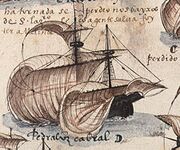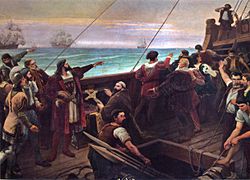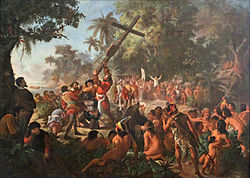History:Discovery of Brazil

The discovery of Brazil (Portuguese: descobrimento do Brasil) refers, from a Eurocentric perspective, to the first arrival of European explorers to the territory of present-day Brazil . The moment is often understood as the sighting of the land later named Island of Vera Cruz, near Monte Pascoal, by the fleet commanded by Portuguese navigator Pedro Álvares Cabral, which occurred on 22 April 1500. Cabral's voyage is part of the so-called Portuguese discoveries.[1][2]
Although almost exclusively used in relation to Pedro Álvares Cabral's voyage, the term "discovery of Brazil" can also refer to the arrival of the expedition led by the Spanish navigator and explorer Vicente Yáñez Pinzón, who reached the Cape of Santo Agostinho, a promontory located in the current state of Pernambuco, on 26 January 1500. This is the oldest confirmed journey to Brazilian territory.[3][4]
The use of the term "discovery" for this historical event considers the viewpoint of peoples from Europe, who had records in the form of written history, and therefore it is a Eurocentric conception of History.
Discovery by Vicente Yáñez Pinzón
Many scholars assert that the real discoverer of Brazil was the Spanish navigator Vicente Yáñez Pinzón, who on 26 January 1500 landed at the Cape of Santo Agostinho, on the southern coast of Pernambuco – considered the earliest documented voyage to what is now Brazilian territory.[1][2][3][4]
The fleet, consisting of four caravels, set sail from Palos de la Frontera on 19 November 1499. After crossing the Equator, Pinzón encountered a severe storm, and then, on 26 January 1500, he sighted the cape and anchored his ships in a sheltered port easily accessible to small boats, with a depth of 16 feet, as indicated by sounding. The mentioned port was the cove of Suape, located on the southern slope of the promontory, which the Spanish expedition named Cape of Santa María de la Consolación. Spain did not claim the discovery, meticulously recorded by Pinzón and documented by important chroniclers of the time such as Peter Martyr d'Anghiera and Bartolomé de las Casas, due to the Treaty of Tordesillas signed with Portugal.[1][3][5][6]
During the night after the landing, they observed large fires burning in the distance, along the northwest coast. The following morning, they sailed in that direction until reaching a river, which Pinzón name "Rio Formoso". On the beach, along the riverbanks, a violent encounter with the local indigenous people, belonging to the Potiguara tribe, was recorded. Heading north, Pinzón rounded the Cape of São Roque and reached the Amazon River in February, which he named Santa María de la Mar Dulce, from where he continued to the Guianas and then to the Caribbean Sea, returning to Spain on 30 September 1500. Pinzón's cousin, Diego de Lepe, undertook a parallel journey, departing from Palos in 1499, twenty days after the departure of Pinzón's fleet. Lepe arrived at the Cape of Santo Agostinho in February 1500, but sailed a few miles to the south, noting that the coast inclined heavily southwest, and then retraced the same trajectory as Pinzón.[1][3]
The map by Juan de la Cosa, a chart made in 1500 at the request of the first kings of Spain – known as the Catholic Monarchs – shows the South American coast adorned with Spanish flags from the Cape de la Vela (in present-day Colombia) to the easternmost point of the continent. There is a text that reads, "Este cavo se descubrio en año de mily IIII X C IX por Castilla syendo descubridor vicentians" (lit. This cape was discovered in 1499 by Castile, with Vicente Yáñez as the discoverer), which most likely refers to Pinzón's arrival at the Cape of Santo Agostinho in late January 1500.[7] Further east, and separated from the mainland, there is an island discovered by Portugal, colored in blue. De la Cosa probably intended to reflect the land discovered by Pedro Álvares Cabral in 1500, which he named "Terra de Vera Cruz" or "de Santa Cruz". The Portuguese believed it to be an island (Island of Vera Cruz) lying in the Atlantic, separating Europe from the Indies.[7]
On 30 October 1500, king Manuel I of Portugal married Maria of Aragon and Castile, daughter of the Catholic Monarchs and sister of his first wife Isabella (who died during a difficult childbirth), initiating a deep dynastic connection between Portugal and Spain. The following year, the first Portuguese expedition to explore the Brazilian coast departed from Lisbon, entrusted to Amerigo Vespucci and commanded by Gonçalo Coelho. On 17 August 1501, the fleet sighted the Cape of São Roque in present-day Rio Grande do Norte, already discovered by Pinzón (latitude calculations were relatively accurate at the time, although longitude was quite faulty). The Portuguese sailed southward, tracing the entire east coast of Brazil. Near Santa Cruz Cabrália, they encountered two exiles from Cabral's fleet, whom they rescued. They then realized that Cabral had discovered not an island, but a stretch of coastline of the new continent. The fleet sailed to the Cape of Santa Maria in present-day Uruguay. The Spanish Crown would later send navigator Juan Díaz de Solís on an expedition to explore the lands allocated to Spain according to the Treaty of Tordesillas – whose imaginary line passed along the coast of the present-day state of São Paulo, near Cananéia.[8][9][10] For his discovery of Brazil, Vicente Yáñez Pinzón was honored by King Ferdinand II of Aragon on 5 September 1501.[11]
Pedro Álvares Cabral's fleet
In order to seal the success of Vasco da Gama's voyage in discovering the sea route to India – which allowed bypassing the Mediterranean, then under the control of the Moors and Italian nations – King Manuel I hastened to outfit a new fleet for the Indies. Since Vasco da Gama's small fleet had struggled to establish itself and engage in trade, this would be the largest fleet assembled by the West up to that point, comprising thirteen vessels and over a thousand men. Except for the names of two ships and a caravel, the names of Cabral's commanded ships are not known. It is estimated that the fleet carried provisions for about eighteen months.
This was the largest squadron ever sent to sail the Atlantic: ten ships, three caravels, and a supply ship. Although the name of the flagship is unknown, the vice-commander's ship of the fleet, Sancho de Tovar's ship, was named El-Rei. Another ship whose name is known is the Anunciada, commanded by Nuno Leitão da Cunha. The latter belonged to Álvaro de Bragança, son of the Duke of Braganza, and was equipped with resources from Bartolomeo Marchionni and Girolamo Sernigi, Florentine bankers residing in Lisbon who invested in the spice trade. The letters they exchanged with their Italian partners and shareholders preserved the ship's name. The name of the caravel commanded by Pero de Ataíde, São Pedro, was also preserved. The other caravel, commanded by Bartolomeu Dias, had its name lost. The fleet was completed by a supply ship commanded by Gaspar de Lemos. It was her responsibility to return to Portugal with news of the discovery of Brazil.

Based on an incomplete document found in the Torre do Tombo in Lisbon, Francisco Adolfo de Varnhagen identified five of the ten ships that made up Cabral's fleet. They were Santa Cruz, Vitória, Flor de la Mar, Espírito Santo, and Espera. The source cited by Varnhagen has never been found again, so most historians prefer not to adopt the names he listed. The fleet, therefore, remains largely anonymous. Other 19th-century historians declared that Cabral's flagship was the legendary São Gabriel, the same ship commanded by Vasco da Gama on the historic voyage that discovered the sea route to India three years earlier. However, there are no documents to support this theory.
Shortly before departure, the King ordered a mass to be said at the Monastery of Belém, presided over by the Bishop of Ceuta, Diogo de Ortiz, in person, where he blessed a flag with the arms of the Kingdom and handed it to Cabral, bidding farewell to the nobleman and the remaining captains. Vasco da Gama reportedly made considerations and recommendations for the impending long journey: coordination among the ships was crucial to prevent them from losing sight of each other. He then recommended to the captain-general to fire the cannons twice and wait for the same response from all other ships before changing course or speed (a counting method still currently used in terrestrial battlefields), among other similar communication codes.
The arrival at Vera Cruz
On 24 April, Cabral, accompanied by Sancho de Tovar, Simão de Miranda, Nicolau Coelho, Aires Correia, and Pero Vaz de Caminha, received a group of indigenous people on his ship, and the natives apparently recognized the gold and silver displayed on the vessel – notably a gold thread and a silver candlestick – which initially led the Portuguese to believe that there was much gold in that land. However, Caminha, in his letter, confesses that he could not ascertain whether the natives were indeed stating that there was gold there, or if the sailors' desire for the metal was so great that they could not interpret it differently. It was later proven that the latter alternative was true.[12]
The encounter between Portuguese and indigenous people is also documented in the letter written by Caminha. The cultural shock was evident. The indigenous people did not recognize the animals brought by the sailors, except for a parrot that the captain had with him; they offered them food and wine, which the indigenous people rejected. They were curious about unfamiliar objects – such as Rosary beads – and the Portuguese were surprised by the recognized objects – the precious metals. It struck the Portuguese as curious and absurd that Cabral had dressed in all the attire and adornments befitting a captain in front of the indigenous people, and yet they passed by him without distinguishing him from the other crew members.
The indigenous people began to learn about the faith of the Portuguese by attending the First Mass, celebrated by Friar Henrique de Coimbra, on a Sunday, 26 April 1500. Shortly after the mass, Cabral's fleet set sail for the Indies, its ultimate destination, but sent one of the ships back to Portugal with Caminha's letter. However, later, with the arrival of Portuguese fleets with the aim of staying in Brazil – and the attempt to evangelize the indigenous people in earnest – the Portuguese realized that the supposed ease of Christianizing the indigenous people translated only into their curiosity about the ritualistic gestures and words of the Europeans, with no real interest in the Catholic faith, which forced the missionaries to rethink their methods of spiritual conquest.
- The sighting of the land and first mass in Brazil
-
Cabral sights the Brazilian mainland for the first time on 22 April 1500, painting by Aurélio de Figueiredo, 1900
-
The raising of the Cross in Porto Seguro, painting by Pedro Peres, 1879
-
The First Mass in Brazil, painting by Victor Meirelles, 1860
The native peoples
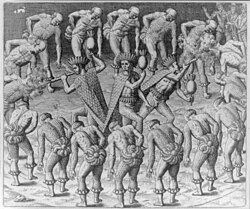
The peoples who inhabited Brazil at the time of Cabral's arrival lived in the Stone Age, transitioning from the Paleolithic to the Neolithic, as they practiced an incipient form of agriculture (corn and cassava) and animal domestication (wild pig and capybara). However, they had extensive knowledge of fermented alcoholic beverage production (more than 80 types), using roots, tubers, barks, and fruits, among other materials as raw ingredients.[13]
Upon the Portuguese arrival in Brazil, the coast of Bahia was occupied by two indigenous nations of the Tupi linguistic group: the Tupinambás, who occupied the stretch between Camamu and the mouth of the São Francisco River; and the Tupiniquins, who extended from Camamu to the border with the current Brazilian state of Espírito Santo. Further inland, occupying the strip parallel to that appropriated by the Tupiniquins, were the Aimorés.
At the beginning of the colonization process of Brazil, the Tupiniquins supported the Portuguese, while their rivals, the Tupinambás, supported the French, who during the 16th and 17th centuries carried out various offensives against Portuguese America. The presence of the Europeans further fueled the hatred between the two tribes, a hatred documented by Hans Staden, a German traveler, during his captivity among the Tupinambás. Both tribes had a culture of cannibalism towards their rivals, a characteristic that for centuries was not understood by the Europeans, resulting in the subsequent persecution of those who refused to change this habit.
Date of discovery in Luso-Brazilian historiography
In historiographical terms, the date of the discovery of Brazil has varied over the centuries:[14]
- Until 1817 – 3 May (according to Gaspar Correia)
- 1817 – 22 April (according to the letter of Pero Vaz de Caminha, which was published by Father Manuel Aires de Casal who found it among the documents brought to Brazil by the Royal Family in 1808)
- 1823 – José Bonifácio proposed the date of the opening of the Constituent Assembly (3 May) to coincide with the date of the discovery (supposedly unaware of Caminha's letter published in 1817).
- From the second half of the 19th century until 1889, the educated Brazilian citizens knew that the date of the discovery was 22 April, although it was not part of the holidays of the Empire.
- 1890 – A republican decree established 3 May as a holiday commemorating the discovery. However, the press at the time already considered 22 April as the correct date.
- 1930 – A decree by Getúlio Vargas abolished the holiday of 3 May. Since then, 22 April has been affirmed as the date.
Theories regarding the discovery of Brazil
There are several assumptions and hypotheses about the discovery of Brazil. The best-known one revolves around a possible secret expedition by the Portuguese navigator Duarte Pacheco Pereira in 1498, aimed at identifying territories belonging to Portugal or Castile according to the Treaty of Tordesillas of 1494 Pereira participated in the treaty negotiations.[15][16] The hypothetical journey is solely based on the explorer's account in Esmeraldo de Situ Orbis (1505), a book he authored. However, the text is ambiguous: Pacheco Pereira explicitly states that the king of Portugal "ordered the discovery of the western part", suggesting he was not speaking of his own explorations but rather of everything already explored by various navigators and known by 1505. This view is supported by the latitudes and longitudes provided, ranging from Greenland to the current southern region of Brazil . Furthermore, the possibility of a policy of secrecy by Portuguese monarchs, proposed in the first half of the 20th century by historian Damião Peres, is not sustainable, as it was common practice, in the absence of a treaty, to claim sovereignty over a land by publicizing its discovery.[16][17]
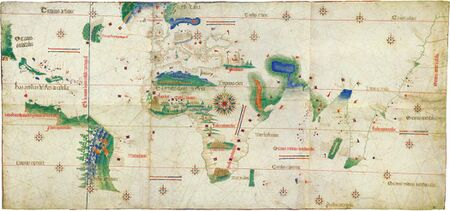
There is also suspicion that the Portuguese discovery of Brazil in 1500 may have been intentional, based on prior knowledge of the territory. As suggested by Pacheco Pereira in Esmeraldo de Situ Orbis, Portuguese navigators in 1498 were instructed by King Manuel I to explore the Atlantic in search of lands. Before heading to India on the 1500 expedition, Pedro Álvares Cabral would have deviated westward beyond necessity to verify the existence of territories as desired by the king. Upon sighting Brazil, Cabral believed he had discovered an island, thus invalidating the theory that he had knowledge of continental lands in those regions. The representation of the then-called Island of Vera Cruz on Juan de la Cosa's map, made the same year, refutes another theory that Portuguese discoveries were secrets not shared with the Spanish. Despite the discovery, Cabral's voyage to India was considered a failure. Cabral received an annual pension of 30 thousand reais for his deeds much less than the 400 thousand reais given to Vasco da Gama in 1498 and was forgotten by the king, dying in obscurity around 1520. His tomb was ignored for three hundred years until it was located in 1839 by historian Francisco Adolfo de Varnhagen.[7][17][18]
There are also theories challenging the locations sighted by Vicente Yáñez Pinzón and Pedro Álvares Cabral. The first Brazilian historian to question the landing of the Spanish navigator at the Cape of Santo Agostinho was the Viscount of Porto Seguro, Francisco Varnhagen, in the mid-19th century.[19] Although Varnhagen acknowledged that Pinzón had been in Brazil before Cabral, he believed the Cape of Santa María de la Consolación to be the tip of Mucuripe in the city of Fortaleza. The thesis was accepted by Admiral Max Justo Guedes but contested by many historians.[20] For the Portuguese, such as Duarte Leite, the Spaniards would have landed north of Cape Orange, in present-day French Guiana.[21] Regarding the location sighted by Pedro Álvares Cabral, there is a thesis advocating for Pico do Cabugi in Rio Grande do Norte as the mountain described by Pero Vaz Caminha, and Praia do Marco as the point of arrival of Cabral's fleet. However, according to the Cantino planisphere (1502), made the year following the exploratory expedition that rescued the two convicts left in Brazil by Cabral, the landing place of the Portuguese navigator is situated south of the Bay of All Saints.[22]
See also
- Pre-Cabraline history of Brazil
- Age of Discovery
References
- ↑ 1.0 1.1 1.2 1.3 1.4 Henri Beuchat. "Manual de arqueología americana" (in es). p. 77. https://books.google.com.br/books?id=5rIVAAAAYAAJ.
- ↑ 2.0 2.1 "Pinzón ou Cabral: quem chegou primeiro ao Brasil?". G1. http://g1.globo.com/pernambuco/projeto-educacao/noticia/2011/10/pinzon-ou-cabral-quem-chegou-primeiro-ao-brasil.html.
- ↑ 3.0 3.1 3.2 3.3 Antonio de Herrera y Tordesillas. "Historia general de los hechos de los Castellanos en las islas y tierra firme de el Mar Oceano, Volume 2" (in es). p. 348. https://books.google.com.br/books?id=wQoiGk0-7f8C.
- ↑ 4.0 4.1 "Martín Alonso Pinzón and Vicente Yáñez Pinzón" (in en). Encyclopædia Britannica. https://www.britannica.com/biography/Martin-Alonso-Pinzon.
- ↑ "Uma história do litoral pernambucano e o porto dos caminhos sinuosos". Unicap. http://www.unicap.br/coloquiodehistoria/wp-content/uploads/2013/11/5Col-p.1331-1344.pdf.
- ↑ "Geoparque Litoral Sul de Pernambuco - CPRM". Serviço Geológico do Brasil. https://www.cprm.gov.br/publique/Gestao-Territorial/Gestao-Territorial/Propostas-de-Geoparques---Projeto-Geoparques-5416.html.
- ↑ 7.0 7.1 7.2 DAVIES, Arthur (1976). "The Date of Juan de la Cosa's World Map and Its Implications for American Discovery". The Geographical Journal 142 (1). págs. 111-116. http://www.jstor.org/stable/1796030. Retrieved 28 January 2024.
- ↑ "D. Manuel I". CM Mirandela. https://www.cm-mirandela.pt/uploads/writer_file/document/169/3370.pdf.
- ↑ Shozo Motoyama. "Prelúdio para uma história: ciência e tecnologia no Brasil". https://books.google.com.br/books/about/Prel%C3%BAdio_para_uma_hist%C3%B3ria.html?hl=pt-BR&id=z_BNPYRNmyYC&redir_esc=y.
- ↑ "Bens tombados em Paranaguá". Secretaria de Estado da Cultura do Paraná. http://www.patrimoniocultural.pr.gov.br/arquivos/File/BIBLIOGRAFIACPC/ESPIRAIS/prg4.pdf.
- ↑ "Capitulación otorgada a Vicente Yáñez Pinzón" (in es). El Historiador. https://www.elhistoriador.com.ar/capitulacion-otorgada-a-vicente-yanez-pinzon/.
- ↑ Pereira, Paulo Roberto (org.). Os três únicos testemunhos do descobrimento do Brasil. In: CAMINHA, Pero Vaz de. Carta de Pero Vaz de Caminha. Rio de Janeiro: Nova Aguilar, 1999. pp. 31–59.
- ↑ Cavalcante, Messias Soares. A verdadeira história da cachaça. São Paulo: Sá Editora, 2011. 608 pp. ISBN:9788588193628
- ↑ Mendonça, Alexandre Ribeiro de. 22 de Abril de 1500ː Descobrimento do Brasil". inː Jornal do Exército, n.º 662, Out. 2016, pp. 38–43.
- ↑ Mota, Avelino Teixeira da. Duarte Pacheco Pereira, capitão e governador de S. Jorge da Mina. Mare Liberum, I(1990), pp. 1–27.
- ↑ 16.0 16.1 "O caso Pacheco Pereira". PÚBLICO. https://www.publico.pt/entrevista/jornal/o-caso-pacheco-pereira-25408499.
- ↑ 17.0 17.1 Duarte Pacheco Pereira. "Esmeraldo de situ orbis". https://books.google.com.br/books/about/Esmeraldo_de_situ_orbis.html?id=cCoNAQAAIAAJ&redir_esc=y.
- ↑ "Varnhagen (1816-1878)". Funag. http://funag.gov.br/biblioteca/download/1156-varnhagen-1816-1878.pdf.
- ↑ Francisco Adolfo de Varnhagen (1858). "Examen de quelques points de l'histoire geographique du bresil comprenant des eclaircissements nouveaux sur le seconde voyage tentrionales du bresil par hojida et par pinzon, sur l'ouvrage de navarrete, sur la veritable ligne de demarcation de tordesillas, sur l'oyapoc ou vincent pinzon, sur le veritable point de vue ou doit se placer tout historien du bresil, etc, ou, analyse critique du rapport de m. d'avezac sur la recente histoire generale du bresil". Biblioteca Digital do Senado Federal (BDSF). http://www2.senado.leg.br/bdsf/item/id/518658.
- ↑ "Cronologia de Fortaleza". Arquivo Nirez. http://arquivonirez.com.br/cronologia-de-fortaleza/.
- ↑ "História dos descobrimentos: colectânea de esparsos, Volume 1". Edições Cosmos. https://books.google.com.br/books/about/Hist%C3%B3ria_dos_descobrimentos.html?id=jj_WAAAAMAAJ&redir_esc=y.
- ↑ "União para provar que Cabral chegou primeiro ao Rio Grande do Norte". O Globo. https://oglobo.globo.com/sociedade/uniao-para-provar-que-cabral-chegou-primeiro-ao-rio-grande-do-norte-21238803.
Further reading
- Ab'Saber, Aziz N. et al. História geral da civilização brasileira. Tomo I: A época colonial - Administração, economia, sociedade. (1.º vol. 4.ª edição). São Paulo: Difusão Europeia do Livro, 1972. 399 pp.
- Boxer, Charles R. O império marítimo português, 1415-1825, "O ouro da Guiné e Preste João (1415-99)". São Paulo: Companhia das Letras, 2002. pp. 31–53.
- Holanda, Sérgio Buarque de. Visão do paraíso, "América Portuguesa e Índias de Castela". São Paulo: Editora Nacional, 1958.
- Léry, Jean de. Viagem à terra do Brasil, "Capítulo XV - De como os americanos tratam os prisioneiros de guerra e das cerimônias observadas ao matá-los e devorá-los". São Paulo: Editora Edusp, 1980. pp. 193–204.
- Staden, Hans. Hans Staden: primeiros registros escritos e ilustrados sobre o Brasil e seus habitantes, "História verídica e descrição de uma terra de selvagens, nus e cruéis comedores de seres humanos...". São Paulo: Editora Terceiro Nome, 1999. pp. 53–84.
External links
 |


